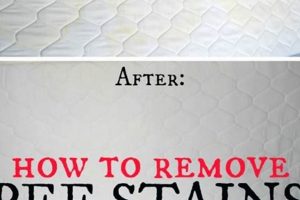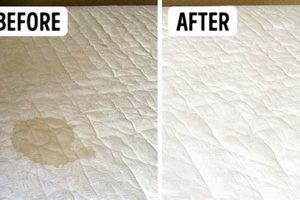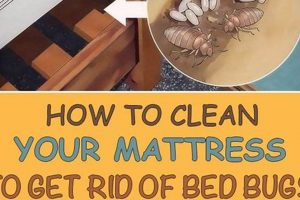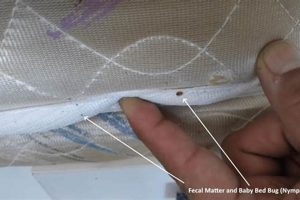The process of eliminating urine discoloration and residue from a bed’s support structure involves a series of cleaning techniques designed to neutralize odors and extract staining agents. Success depends on the promptness of the cleaning effort and the nature of the materials involved. For instance, a freshly deposited stain on a cotton mattress requires different treatment than an older, deeply penetrated stain on a memory foam surface.
Effective elimination of such stains preserves the hygiene and longevity of the mattress. Addressing these stains promptly and thoroughly prevents the growth of bacteria and mold, contributing to a healthier sleep environment. Historically, various methods have been employed, from simple sun-drying to the application of homemade solutions, reflecting the ongoing need to maintain the cleanliness of bedding.
Understanding the composition of urine and its interaction with mattress materials is crucial for selecting the appropriate cleaning agents and methods. The subsequent sections will detail specific approaches, outlining the necessary materials and step-by-step procedures for effective stain removal and odor neutralization.
Tips for Addressing Urine Stains on Mattresses
The following guidelines offer practical steps for managing urine stains on mattresses, aimed at mitigating damage and restoring hygiene.
Tip 1: Immediate Action: Prompt response is critical. Excess liquid should be absorbed immediately with clean towels or absorbent cloths to minimize penetration into the mattress fibers.
Tip 2: Cold Water Rinse: Applying cold water to the affected area can help dilute the urine and prevent it from setting. Avoid hot water, as it can cause the stain to bind more strongly to the material.
Tip 3: Enzyme Cleaner Application: Enzyme-based cleaners are designed to break down the organic compounds present in urine. Follow the manufacturer’s instructions carefully, ensuring thorough saturation of the stain.
Tip 4: Baking Soda Neutralization: After cleaning, a generous layer of baking soda can be applied to absorb residual moisture and neutralize odors. Allow the baking soda to sit for several hours, ideally overnight.
Tip 5: Vacuuming Residue: Once the baking soda has absorbed moisture and odors, vacuum the area thoroughly to remove the powder and any remaining residue.
Tip 6: Ventilation and Drying: Proper ventilation is essential for complete drying. Open windows or use a fan to circulate air and prevent mold growth.
Tip 7: Consider Professional Cleaning: For stubborn or deeply embedded stains, professional mattress cleaning services can provide specialized equipment and techniques for effective removal.
Adhering to these tips can significantly improve the chances of successfully removing urine stains and restoring the mattress to a hygienic condition. Diligence and appropriate cleaning agents are key to achieving desired results.
The subsequent section will address preventative measures to protect mattresses from future incidents and maintain their overall cleanliness.
1. Prompt stain treatment
The efficacy of removing urine stains from a mattress is directly correlated with the immediacy of treatment. The porous nature of mattress materials allows urine to penetrate deeply, resulting in more stubborn stains and persistent odors if left unattended. Prompt action minimizes the extent of absorption, thereby simplifying the subsequent cleaning process. Delayed intervention allows the urine to dry and chemically bond with the mattress fibers, requiring more aggressive cleaning methods that could potentially damage the material.
The cause-and-effect relationship is evident. The faster the response, the less urine permeates the mattress, leading to easier stain removal and odor neutralization. Conversely, neglecting immediate treatment necessitates stronger cleaning agents, increased cleaning time, and a potentially incomplete removal of the stain and odor. A practical example is a urine accident during the night. Addressing it first thing in the morning yields better results than postponing the cleaning for several days. Immediate blotting of the urine with absorbent materials, followed by targeted cleaning solutions, markedly improves the outcome.
In summary, prompt stain treatment forms a cornerstone of successful urine stain removal from mattresses. It reduces the severity of the stain, simplifies the cleaning process, and minimizes the risk of lasting odors or material damage. This proactive approach, therefore, proves essential for maintaining mattress hygiene and prolonging its lifespan.
2. Appropriate cleaning agents
The selection of cleaning agents is paramount in effectively addressing urine stains on a mattress. The composition of urine, combined with the porous nature of mattress materials, necessitates the use of specific cleaning solutions designed to break down and neutralize the stain-causing compounds. Inadequate or inappropriate cleaning agents may fail to remove the stain completely, leading to persistent odors and potential damage to the mattress.
- Enzymatic Cleaners
Enzymatic cleaners contain enzymes that specifically target and break down the uric acid crystals present in urine. This breakdown process effectively eliminates both the stain and the odor. A common example is the use of protease and amylase enzymes. The efficacy of enzymatic cleaners lies in their ability to digest the organic components of urine, unlike general-purpose cleaners that may simply mask the odor or spread the stain. Their implication is a thorough and lasting removal of the urine stain, preserving the integrity of the mattress.
- Vinegar Solutions
White vinegar, a mild acid, can be used to neutralize the alkaline components of urine. The acetic acid in vinegar helps to dissolve the uric acid crystals and neutralize the ammonia odor. A diluted vinegar solution is a safer alternative to harsh chemicals, especially for mattresses made of delicate materials. For instance, a solution of equal parts white vinegar and water can be applied to the stain, allowed to sit for a period, and then blotted dry. The implication is a safer and environmentally conscious cleaning option, albeit potentially less effective on older or deeply embedded stains.
- Baking Soda Paste
Baking soda (sodium bicarbonate) is an alkaline substance that can absorb odors and moisture. When mixed with water to form a paste, it can be applied to the urine stain to draw out the moisture and neutralize the odor. After drying, the baking soda can be vacuumed away, leaving the mattress fresher. An example of its use is creating a thick paste of baking soda and water, applying it generously to the affected area, and allowing it to dry completely before vacuuming. The implication is a cost-effective and non-toxic method for deodorizing the mattress, particularly effective when used in conjunction with other cleaning agents.
- Hydrogen Peroxide
Hydrogen peroxide is an oxidizing agent that can bleach and disinfect. It can be used to lighten the urine stain and kill bacteria. However, caution is advised as it may cause discoloration or damage to certain mattress materials. A diluted hydrogen peroxide solution (3%) can be sprayed onto the stain, allowed to sit for a short period, and then blotted dry. The implication is a powerful stain remover, but its use requires careful consideration of the mattress material to avoid unintended bleaching or degradation.
The effectiveness of “getting rid of urine stains on mattress” is intimately linked to the selection and application of appropriate cleaning agents. Enzymatic cleaners offer a targeted approach to breaking down urine compounds, while vinegar, baking soda, and hydrogen peroxide provide alternative solutions with varying degrees of efficacy and risk. The choice of cleaning agent should be based on the nature of the stain, the material of the mattress, and the desired balance between cleaning power and material safety.
3. Thorough stain saturation
The concept of thorough stain saturation is intrinsically linked to the successful elimination of urine stains from mattresses. Effective stain removal hinges on ensuring that the cleaning agent permeates all affected areas of the mattress, reaching deep within the fibers to counteract the stain-causing compounds.
- Penetration of Cleaning Agents
Thorough saturation facilitates the deep penetration of cleaning agents into the mattress fibers, ensuring that all urine deposits are exposed to the cleaning solution. This is crucial because urine can seep deep into the mattress layers, making surface cleaning inadequate. For instance, when using an enzymatic cleaner, saturation allows the enzymes to reach and break down all the uric acid crystals present within the mattress. The implication is that incomplete saturation leads to residual stain and odor, necessitating repeated cleaning attempts or potentially resulting in permanent damage.
- Dissolving Stain Compounds
Saturation provides sufficient contact time between the cleaning agent and the urine stain, allowing the agent to effectively dissolve the stain compounds. The longer the contact, the more the cleaning agent can break down the complex molecules that cause the stain and odor. Consider a scenario where a baking soda paste is applied; thorough saturation ensures that the paste remains in contact with the stain long enough to absorb the urine and neutralize the odor. The implication is that insufficient saturation results in incomplete dissolving of the stain, leaving behind visible discoloration and lingering smells.
- Neutralizing Odor Sources
Urine stains are often accompanied by persistent odors that can be difficult to eliminate. Thorough saturation ensures that the cleaning agent reaches all odor-causing sources, neutralizing them effectively. For example, when using a vinegar solution, saturation allows the acetic acid to neutralize the ammonia present in urine. The implication is that inadequate saturation leaves pockets of odor-causing substances, leading to a lingering unpleasant smell that undermines the overall cleaning effort.
- Preventing Stain Setting
By saturating the stain with a cleaning agent, the stain can be prevented from further setting into the mattress fibers. The cleaning agent acts as a barrier, preventing the urine from bonding more strongly with the material. Consider a situation where an enzyme cleaner is used promptly after an accident; thorough saturation prevents the urine from drying and setting into the mattress, making it easier to remove. The implication is that inadequate saturation allows the stain to set, making subsequent removal more challenging and potentially requiring professional cleaning services.
In conclusion, thorough stain saturation is an indispensable step in the process of “getting rid of urine stains on mattress”. It ensures deep penetration of cleaning agents, effective dissolving of stain compounds, neutralization of odor sources, and prevention of stain setting. By diligently saturating the affected area, individuals can significantly increase the likelihood of complete stain removal and restoration of mattress hygiene.
4. Complete moisture extraction
Complete moisture extraction is a critical step in eliminating urine stains from mattresses, directly impacting the effectiveness and longevity of the cleaning process. Residual moisture can foster bacterial growth, mold development, and persistent odors, thereby undermining the efforts to restore mattress hygiene.
- Prevention of Microbial Growth
Residual moisture provides an ideal environment for bacteria and mold to proliferate. These microorganisms contribute to unpleasant odors and can pose health risks. Thorough moisture extraction removes this breeding ground, minimizing the likelihood of microbial growth. For instance, after applying a cleaning solution, if the mattress remains damp, mold spores present in the air can colonize the area within 24-48 hours. The implication is that inadequate moisture extraction negates the benefits of cleaning by introducing new problems.
- Odor Elimination Enhancement
Urine odors can linger if moisture remains trapped within the mattress fibers. Complete moisture extraction aids in eliminating these odors by removing the medium in which the odor-causing compounds reside. Baking soda, for example, absorbs moisture and odors, but its effectiveness is maximized when followed by thorough vacuuming to extract both the powder and the trapped moisture. The implication is that failure to extract moisture can result in persistent odors that necessitate further cleaning attempts.
- Maintenance of Mattress Integrity
Excessive moisture can weaken mattress fibers and compromise the structural integrity of the mattress. Over time, prolonged dampness can lead to the breakdown of foam, the rusting of springs, and the deterioration of fabric. Professional extraction methods, such as using a wet/dry vacuum, remove deep-seated moisture without damaging the mattress. The implication is that incomplete moisture extraction can shorten the lifespan of the mattress and diminish its comfort.
- Prevention of Stain Reappearance
Moisture can draw residual urine compounds to the surface, leading to the reappearance of the stain even after cleaning. Complete extraction prevents this by removing these compounds along with the moisture. Consider a scenario where a surface stain appears to be removed, but as the mattress dries, the stain resurfaces due to the migration of deeper urine deposits. The implication is that thorough moisture extraction is essential for ensuring that the stain does not return after the cleaning process.
In summary, complete moisture extraction is an indispensable element in effectively addressing urine stains on mattresses. It prevents microbial growth, enhances odor elimination, maintains mattress integrity, and prevents stain reappearance. By prioritizing thorough extraction, individuals can maximize the success of their cleaning efforts and ensure a hygienic and comfortable sleep environment.
5. Odor neutralization methods
The elimination of urine stains from mattresses necessitates not only the removal of visible discoloration but also the eradication of persistent odors. Odor neutralization methods form an integral component of a comprehensive cleaning strategy, addressing the volatile compounds that cause the unpleasant smell.
- Enzymatic Action
Enzymatic cleaners contain enzymes specifically designed to break down the uric acid crystals present in urine, the primary source of the characteristic odor. These enzymes digest the organic compounds, effectively neutralizing the smell rather than simply masking it. An example is the use of protease and urease enzymes, which cleave peptide bonds and hydrolyze urea, respectively. Their proper use eliminates the source of odor, preventing its recurrence.
- Baking Soda Absorption
Sodium bicarbonate, commonly known as baking soda, possesses inherent odor-absorbing properties. Its porous structure allows it to trap volatile molecules, thereby reducing the concentration of odor-causing compounds in the surrounding air. Applying a layer of baking soda to the affected area and allowing it to sit for several hours facilitates the absorption of residual odors, providing a non-toxic means of deodorization.
- Vinegar Neutralization
Acetic acid, the active component in white vinegar, is a mild acid that can neutralize alkaline compounds, including ammonia, a significant contributor to urine odor. Diluted vinegar solutions can be applied to the affected area to counteract the alkaline compounds, neutralizing the odor. This approach offers a cost-effective alternative to commercially formulated odor neutralizers.
- Activated Charcoal Filtration
Activated charcoal, also known as activated carbon, possesses a high surface area, enabling it to effectively adsorb various volatile organic compounds responsible for urine odors. Placing containers of activated charcoal near the treated mattress can further reduce lingering smells by trapping airborne odor molecules, providing an additional layer of deodorization.
The successful execution of “getting rid of urine stains on mattress” requires the strategic implementation of appropriate odor neutralization methods. Enzymatic action targets the source of the odor, while baking soda, vinegar, and activated charcoal offer complementary approaches to absorb and neutralize residual volatile compounds. Employing a combination of these methods maximizes the likelihood of achieving complete odor elimination and restoring mattress hygiene.
6. Preventive mattress protection
The implementation of proactive mattress protection measures is fundamentally linked to minimizing the need for, and complexity of, stain removal efforts. The intent of such preventative strategies is to create a barrier, shielding the mattress from direct contact with urine and thereby mitigating the potential for staining and odor absorption. The following points illustrate this relationship.
- Waterproof Mattress Encasements
Waterproof mattress encasements provide a complete seal around the mattress, preventing liquids from penetrating the surface. This barrier is crucial in households with children, pets, or individuals prone to incontinence. For example, a high-quality polyurethane or vinyl encasement will repel urine, preventing it from reaching the mattress fibers. The implication is a significantly reduced likelihood of stain formation and odor retention, simplifying routine cleaning efforts and prolonging mattress lifespan.
- Absorbent Mattress Pads
Absorbent mattress pads offer an additional layer of protection by absorbing minor spills and accidents before they reach the mattress. These pads are typically made of cotton, microfiber, or other absorbent materials and can be easily removed and laundered. For instance, a quilted mattress pad can absorb a small amount of urine, providing valuable time to address the spill before it penetrates deeper. The implication is a lessened impact from small incidents, reducing the need for aggressive cleaning treatments and minimizing the risk of lasting stains.
- Regular Cleaning and Maintenance
Routine vacuuming and spot cleaning can prevent the accumulation of dust, allergens, and minor stains that can exacerbate the impact of a urine accident. Regularly cleaning the mattress surface removes potential contaminants that could interact with urine, making stains more difficult to remove. An example is vacuuming the mattress monthly to remove dust mites and debris. The implication is a cleaner baseline, making subsequent stain removal efforts more effective and minimizing the potential for long-term damage.
- Prompt Response to Accidents
Even with protective measures in place, prompt action following an accident is crucial. Quickly blotting up any spills and applying appropriate cleaning agents can minimize the stain’s severity and prevent it from setting. For instance, immediately blotting urine with absorbent towels prevents it from soaking deeper into the mattress, even with a mattress pad in place. The implication is that while protective measures reduce the risk, vigilance and timely response remain essential components of stain prevention.
In essence, “Preventive mattress protection” serves as a proactive measure that reduces the incidence and severity of urine stains, thereby decreasing the necessity for extensive stain removal procedures. By implementing waterproof encasements, using absorbent pads, maintaining cleanliness, and responding promptly to accidents, individuals can significantly mitigate the impact of urine incidents and preserve the integrity of their mattresses.
Frequently Asked Questions
The following section addresses common inquiries regarding the removal of urine stains from mattresses, offering concise and practical information.
Question 1: Does the age of the urine stain impact the difficulty of removal?
Yes, the age of the stain significantly affects the ease of removal. Fresh urine stains are generally easier to treat because the urine has not had time to deeply penetrate the mattress fibers or chemically bond with the material. Older stains are more challenging due to deeper penetration and potential chemical changes, often requiring more aggressive cleaning methods.
Question 2: Can any cleaning agent be used on a urine stain?
No, not all cleaning agents are suitable. It is important to use cleaning agents specifically designed to break down the components of urine, such as enzymatic cleaners. General-purpose cleaners may not effectively remove the stain and odor, and some harsh chemicals can damage the mattress material.
Question 3: Is it necessary to treat both sides of the mattress?
The extent of urine penetration determines whether both sides require treatment. If the stain is relatively small and addressed promptly, treating only the affected side may suffice. However, if the urine has soaked through to the other side, treating both sides is necessary to ensure complete removal of the stain and odor.
Question 4: How can lingering odors be eliminated after stain removal?
Lingering odors can be addressed using odor-absorbing substances such as baking soda. A generous layer of baking soda should be applied to the cleaned area and allowed to sit for several hours, preferably overnight, before being vacuumed away. This process helps to neutralize any remaining odor molecules.
Question 5: Are professional mattress cleaning services recommended?
Professional cleaning services are recommended for stubborn or deeply embedded stains, as well as for valuable or delicate mattresses. Professionals possess specialized equipment and expertise to safely and effectively remove urine stains without damaging the mattress.
Question 6: What preventative measures can be taken to protect mattresses from future incidents?
Preventative measures include the use of waterproof mattress encasements or pads. These barriers protect the mattress from liquid penetration, minimizing the risk of stains and odors. Regular cleaning and prompt response to accidents further enhance mattress protection.
Successful removal of urine stains from mattresses relies on prompt action, the selection of appropriate cleaning agents, and thoroughness in treatment. Addressing both the stain and any lingering odors is essential for restoring mattress hygiene.
The subsequent section will provide a concise summary of the key steps involved in effective mattress cleaning and stain removal.
Conclusion
The preceding discussion has meticulously explored the methodologies and considerations involved in getting rid of urine stains on mattress surfaces. Key elements identified include the urgency of initial treatment, the selection of appropriate cleaning solutions tailored to the stain’s composition and the mattress material, and the necessity of thorough extraction and odor neutralization techniques. Furthermore, proactive preventative measures are paramount in mitigating the likelihood of future incidents.
The preservation of mattress hygiene remains a critical aspect of maintaining a healthy sleep environment. Therefore, adherence to the principles outlined herein constitutes a prudent investment in both the longevity of the bedding and the well-being of its users. Consistent application of these strategies will yield tangible benefits, safeguarding against potential health risks and ensuring a more sanitary and restful sleep experience.







